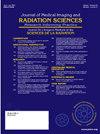哪一个对全颈部放射治疗的剂量分布影响更大,每日颈部体积变化,还是残余设置误差?
IF 1.3
Q3 RADIOLOGY, NUCLEAR MEDICINE & MEDICAL IMAGING
Journal of Medical Imaging and Radiation Sciences
Pub Date : 2025-05-11
DOI:10.1016/j.jmir.2025.101968
引用次数: 0
摘要
在头颈部放射治疗中,由于患者体积或肿瘤形状的变化,需要重新规划治疗方案。由于PreciseARTⓇ的剂量计算是根据巨压ct图像自动确定的,因此监测每日体积变化对剂量分布的影响可以帮助在最佳时间利用Re-CT图像进行治疗计划的重新规划。然而,除非确定了影响体积变化或设置错误的因素,否则很难在最佳时间进行治疗重新计划。因此,本研究旨在推断主要影响因素。方法30例在静冈县癌症中心接受调强放疗的头颈部患者加入本研究。评估每体积变化的剂量分布和设置误差的差异,以获得相关系数。体积变化被定义为颈部区域结构体积的变化,设置误差被定义为在俯仰、偏转(即残余设置误差)和肩部位置对图像进行整理时椎体位置的不可纠正差异。结果D95%_CTV的体积变化相关系数最高,为- 0.71,其次是Dmean_CTV的- 0.68,Dmean_PTV的- 0.63。辐射剂量与设置误差的相关性低于体积变化与辐射剂量的相关性。结论颈部体积变化对剂量分布的影响大于剩余设置误差。本文章由计算机程序翻译,如有差异,请以英文原文为准。
Which has more influence on dose distribution for whole neck radiation therapy, daily neck volume change, or residual setup errors?
Introduction
The demand for treatment replanning has been reported in radiation therapy for the head-and-neck region because of changes in the patient’s volume or tumor shape. As the dose calculation for PreciseARTⓇ is automatically determined based on megavoltage computed tomography images, monitoring the impacts of daily volume changes on the dose distribution could help performing the treatment replanning with Re-CT images at most optimal time. However, performing treatment replanning at the optimal timing is difficult unless the factors influencing volume changes or setup errors are determined. Therefore, this study aimed to infer the major influencing factors.
Methods
Thirty patients who underwent intensity-modulated radiation therapy in the head-and-neck region at Shizuoka Cancer Center were enrolled in this study. The differences in the dose distributions per volume change and setup error were evaluated to obtain correlation coefficients. Volume changes were defined as a change in structure volume for the neck region, and setup errors were defined as uncorrectable differences in the vertebral body positions when images are collated in pitch, yaw (i.e., residual setup error), and at shoulder positions.
Results
The highest correlation value coefficient indicates the volume change with −0.71 for D95%_CTV, followed by −0.68 for Dmean_CTV, and −0.63 for Dmean_PTV. The correlation between the radiation dose and setup errors was lower than between volume change and radiation dose.
Conclusion
Based on our findings, neck volume change has a greater impact on dose distribution compared to residual setup errors.
求助全文
通过发布文献求助,成功后即可免费获取论文全文。
去求助
来源期刊

Journal of Medical Imaging and Radiation Sciences
RADIOLOGY, NUCLEAR MEDICINE & MEDICAL IMAGING-
CiteScore
2.30
自引率
11.10%
发文量
231
审稿时长
53 days
期刊介绍:
Journal of Medical Imaging and Radiation Sciences is the official peer-reviewed journal of the Canadian Association of Medical Radiation Technologists. This journal is published four times a year and is circulated to approximately 11,000 medical radiation technologists, libraries and radiology departments throughout Canada, the United States and overseas. The Journal publishes articles on recent research, new technology and techniques, professional practices, technologists viewpoints as well as relevant book reviews.
 求助内容:
求助内容: 应助结果提醒方式:
应助结果提醒方式:


